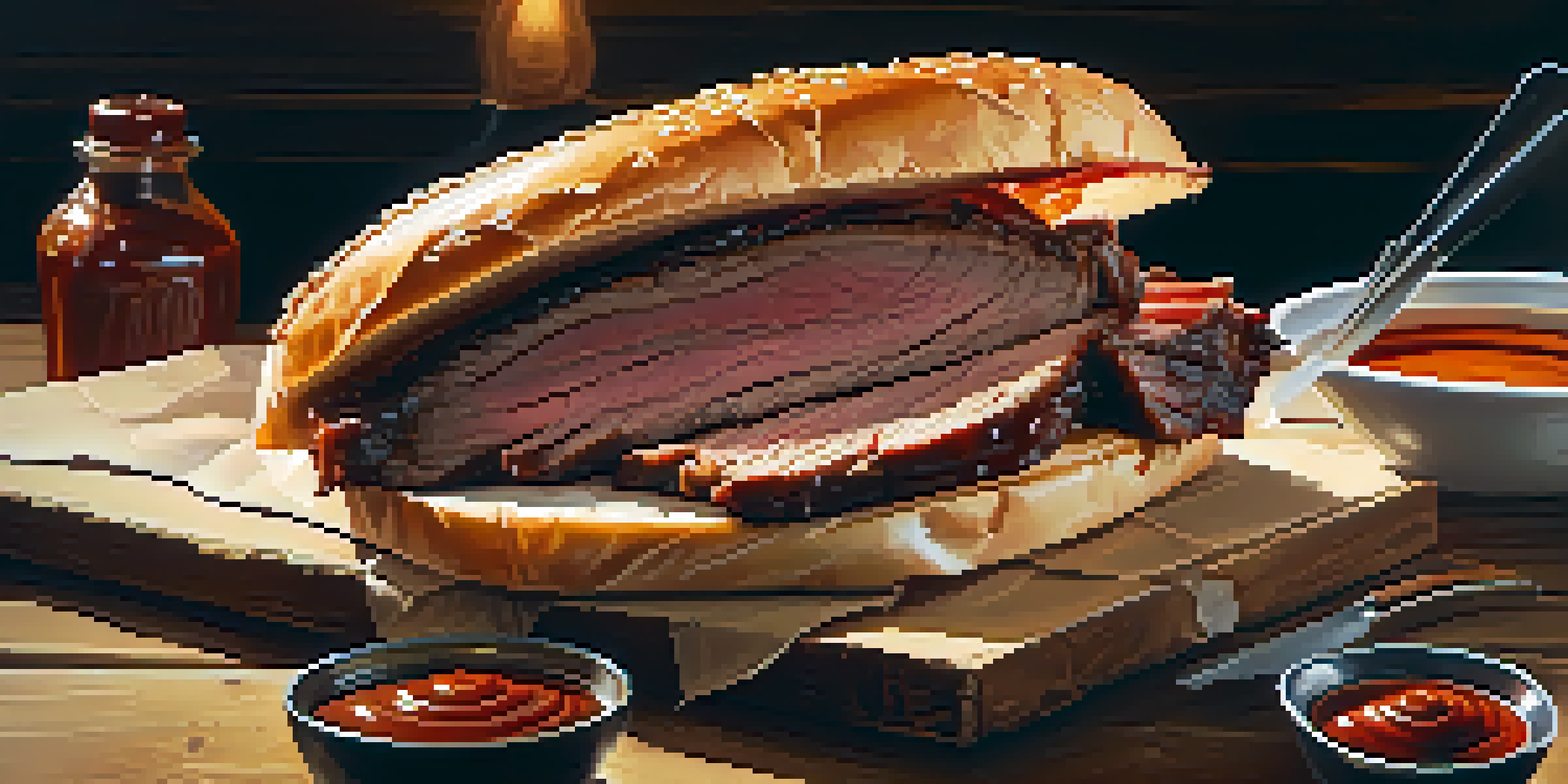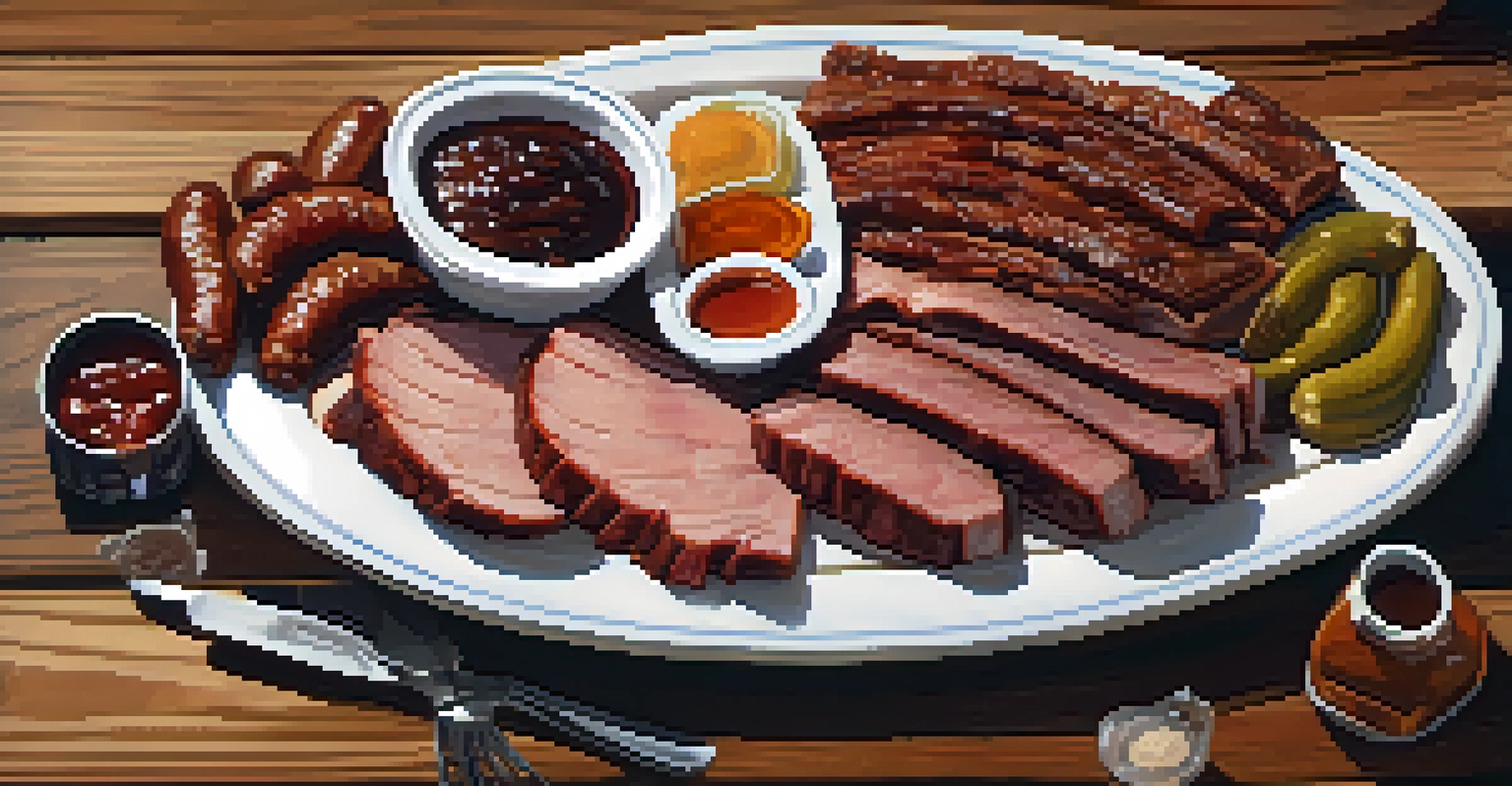The Rich History of Texas Barbecue: A Culinary Tradition

The Origins of Texas Barbecue: A Blend of Cultures
Texas barbecue has deep roots that intertwine various cultural influences, primarily from Native American, Mexican, and European settlers. Each group brought unique techniques and flavors to the table, shaping what we now recognize as Texas barbecue. For example, Native Americans introduced smoking meats, while Mexican cuisine contributed marinated meats cooked over open flames.
Barbecue may not be the road to world peace, but it's a start.
As settlers moved westward, they adapted their cooking methods to the resources available, leading to the use of different woods and meats. The practice of slow-cooking over indirect heat became a hallmark of Texas barbecue, allowing tough cuts of meat to become tender and flavorful. This culinary tradition exemplifies how food can reflect the diverse backgrounds of a region's inhabitants.
Today, this melting pot of flavors continues to influence Texas barbecue, creating a rich tapestry of tastes and techniques. It's fascinating to see how these initial influences have evolved into the signature styles we enjoy today, such as Central Texas brisket and East Texas chopped beef.
The Role of Smoke: How It Defines Texas Barbecue
Smoke is a defining element of Texas barbecue, playing a critical role in flavor development and preservation. The choice of wood—such as oak, mesquite, or pecan—can dramatically change the taste profile of the meat. For instance, mesquite provides a strong, robust flavor, while pecan offers a milder, sweeter smoke that can complement various meats.

Pitmasters often spend years perfecting their smoking techniques, which can include variations in temperature, humidity, and even the timing of when to add wood. This meticulous attention to detail underscores the artistry behind Texas barbecue and emphasizes that it's not just about cooking meat; it's about crafting a unique flavor experience. When you bite into a perfectly smoked brisket, you’re tasting the passion and dedication of those who have mastered this craft.
Cultural Influences Shape Barbecue
Texas barbecue is a unique blend of Native American, Mexican, and European culinary traditions that have evolved over time.
Moreover, the communal aspect of smoking meat—often done in backyards and at family gatherings—adds to the cultural significance of barbecue in Texas. It’s a time for sharing stories and creating memories, all centered around the delicious smoke-kissed flavors that define this culinary tradition.
Barbecue Styles Across Texas: A Regional Breakdown
The vastness of Texas means a variety of barbecue styles exist within its borders, each with distinct characteristics. In Central Texas, the focus is primarily on beef, especially brisket, served with minimal seasoning to highlight the meat's natural flavors. Here, you'll find the iconic smoked brisket, often accompanied by simple sides like pickles and onions, allowing the meat to shine.
Barbecue is a way of life in Texas, a culinary tradition that brings people together.
East Texas, on the other hand, leans towards a more sauced approach, featuring chopped beef sandwiches and smoked sausage. Barbecue joints in this region often use sweeter, tomato-based sauces that complement the smoky flavors of the meat. This style reflects the region's Southern roots and highlights how barbecue can adapt to local tastes and preferences.
Moving to West Texas, you'll encounter a mix of barbecue styles influenced by Mexican cuisine. Here, you might find smoked brisket tacos or carne asada, showcasing how Texas barbecue continues to evolve by blending cultural influences. Each region's unique take on barbecue tells a story of its history, geography, and the people who call it home.
The Evolution of Barbecue Joints in Texas
Barbecue joints have been a staple in Texas for decades, evolving from humble roadside stands to gourmet establishments. Originally, these small eateries served the working-class population, providing hearty meals at affordable prices. The atmosphere was often casual, with picnic tables and a 'come as you are' vibe that welcomed everyone.
As barbecue gained popularity, many pitmasters began to elevate their craft, focusing on quality ingredients and innovative techniques. Today, you can find a range of barbecue joints, from traditional smokehouses to modern establishments that experiment with flavors and presentation. This evolution reflects the growing appreciation for barbecue as a culinary art form, rather than just a means of sustenance.
Smoke Defines Flavor Experience
The choice of wood and meticulous smoking techniques are crucial in developing the rich flavors that characterize Texas barbecue.
Moreover, the rise of food festivals and competitions has further propelled the barbecue scene in Texas. Events like the Houston Barbecue Festival and the Texas Monthly BBQ Fest celebrate the diversity of styles and techniques, bringing together pitmasters from across the state to showcase their talents. This not only fosters community but also encourages creativity and innovation in the barbecue world.
The Influence of Barbecue on Texas Culture and Identity
Barbecue in Texas is more than just food; it represents a cultural identity and a sense of belonging. From family gatherings to community cook-offs, barbecue brings people together, creating bonds over shared experiences and flavors. It’s common to see friends and families gathered around a smoky pit, sharing stories and laughter while enjoying delicious food.
This culinary tradition is also deeply embedded in Texas pride. Many Texans take their barbecue seriously, with regional rivalries reflecting the passion for different styles and techniques. The debate over which barbecue joint reigns supreme can spark lively discussions, showcasing how food can evoke strong emotions and a sense of loyalty.
As Texas continues to grow and diversify, barbecue remains a unifying force, bridging gaps between different communities. It’s a culinary tradition that honors the past while embracing the future, reminding us of the rich history that flavors every bite.
Texas Barbecue: A Journey from Pit to Plate
The journey of Texas barbecue is one that requires patience and skill, starting right at the pit. Pitmasters dedicate countless hours to monitoring the temperature, adding wood as needed, and ensuring that each cut of meat is cooked to perfection. This commitment to the craft is what sets Texas barbecue apart from other barbecue styles across the country.
Once the meat is ready, it's not just about serving it; presentation matters, too. Many barbecue joints take pride in how they serve their food, often showcasing the beautifully smoked meats on butcher paper. This simple yet effective presentation emphasizes the rustic charm of barbecue and creates an inviting experience for diners.
Barbecue as a Cultural Identity
Barbecue in Texas fosters community and pride, uniting people through shared experiences and regional culinary rivalries.
Finally, the moment of truth arrives when the first bite is taken. The smoky aroma, tender texture, and rich flavors encapsulate the hard work and passion that went into making the barbecue. It’s a sensory experience that not only satisfies hunger but also connects people to the deep-rooted traditions of Texas barbecue, making each meal a celebration of culinary history.
Savoring Texas Barbecue: Tips for the Perfect Experience
To truly enjoy Texas barbecue, it’s essential to approach the experience with an open mind and a hearty appetite. Start by sampling a variety of meats, including brisket, ribs, and sausage, to appreciate the depth of flavors each offers. Don’t hesitate to mix and match with sides like coleslaw or potato salad, which can enhance your meal and provide a refreshing contrast to the smoky richness of the barbecue.
When it comes to sauces, remember that they vary by region and personal preference. Some may prefer their meat dry, letting the smoke speak for itself, while others might enjoy a tangy or sweet sauce slathered on top. Experimenting with different sauces can lead to delightful discoveries, so don’t shy away from asking for recommendations at your local barbecue joint.

Lastly, take your time to savor each bite and engage in conversation with those around you. Barbecue is meant to be enjoyed leisurely, allowing moments of connection and enjoyment. Whether at a family gathering or a bustling barbecue festival, the experience of savoring Texas barbecue is one that lingers long after the last bite.